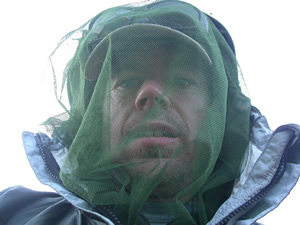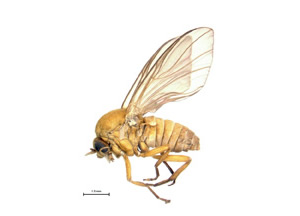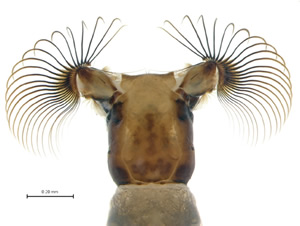Tiny barbarians at the gate
Tiny barbarians at the gate
Submitted by Ned Rozell
Phone: 907-474-7468
04/23/09



Mosquitoes and black flies, now stirring after a long winter, have probably helped assure that most of Alaska remains unpopulated, says an expert on the creatures.
"I’ve spent a lot of time in the far north, in Canada, Siberia, and Alaska," said Peter Adler, a professor of entomology at Clemson University. "You can go down rivers for a month or two at a time and see no humans. Why is that? What’s keeping them out?"
"There are two main features that might play a role, bitterly cold winters and biting flies."
Adler is interested in the latter element, so much so that he waded through streams in western Alaska and far-east Russia a few years ago, finding and describing the black flies and mosquitoes of the regions. He undertook the expedition because he was curious, and because no one had cataloged in detail the biting flies of the former land mass known as Beringia, now cleaved in two by the Bering Strait.
Armed with his field kit, which consists of rubber boots, a 10x hand lens, a vial containing a preservative solution of alcohol and acetic acid, and a set of jeweler’s forceps used to pluck black fly larvae from rocks, Adler combed the waterways of western Alaska and far-east Russia.
He and Doug Currie of the University of Toronto rented a car in Nome, drove every road they could, and stopped at streams to take samples of black flies. They also flew into the upper Kisaralik River, a tributary of the Kuskokwim River, and floated out, gathering larvae along the way. They also explored the Anadyr River in Russia, plucking samples with forceps and using finely woven dip nets in slower waters.
After a close-up look at each species of black fly, Adler could tell if the female’s claw had a thumb-like lobe, which is used to clutch feathers when cutting a bird for a blood meal, or a curved talon that is used by flies to feed on mammal blood. Adler found that almost a quarter of the black flies lacked scissor-like, serrated mouthparts and had no need for blood, having acquired all their nutrition as larvae in the water. Two species had simplified their lives further by producing no males; instead females reproduce by virgin birth (parthenogenesis).
Adler also found evidence of the Cold War as it applied to black flies and mosquitoes. In several instances, Russian scientists and American scientists working on opposite sides of Bering Strait had each given the same insect different names.
"We found that more than half of the black flies are shared (between the Russia and Alaska sides of the Bering Strait)," Adler said. "And 70 percent of the mosquito species are shared."
Those findings didn’t surprise Adler, as the land bridge existed in the area until about 11,000 years ago, and the 62-mile barrier between Wales, Alaska and Uelen, Russia is not too far a distance for a biting fly to cover, given a sufficient wind. He thinks such pests as the striped black fly, Simulium vittatum, a current resident of North America, could easily cross over to Russia, and the same applies to species hovering at the western edge of Russia.
"Some are poised there, ready to make that leap across the Bering Strait," Adler said.
Genetic evidence also tells him that several species of black fly have found their way to the Seward Peninsula from farther south.
"If it continues to warm, then species from more southerly climes will keep working northward," he said. "At some point in the future, you would expect western Alaska to have many more (species of black flies and mosquitoes)."
Those biting flies will have plenty of company. Adler cited other scientists who have measured more than 600,000 black fly larvae in about three square feet of streambed, and more than 12 million adult mosquitoes hovering above one unfortunate acre of northern tundra.


